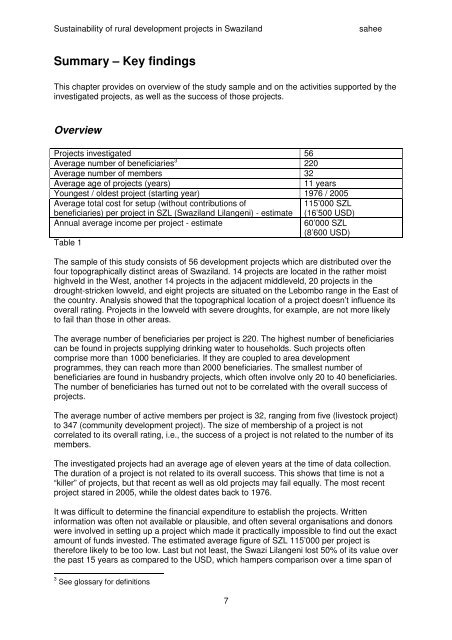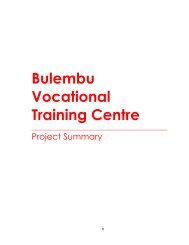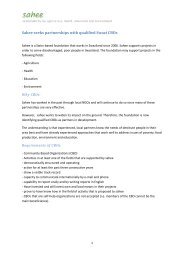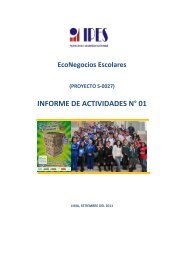Sustainability of rural development projects in ... - sahee foundation
Sustainability of rural development projects in ... - sahee foundation
Sustainability of rural development projects in ... - sahee foundation
Create successful ePaper yourself
Turn your PDF publications into a flip-book with our unique Google optimized e-Paper software.
<strong>Susta<strong>in</strong>ability</strong> <strong>of</strong> <strong>rural</strong> <strong>development</strong> <strong>projects</strong> <strong>in</strong> Swaziland<br />
<strong>sahee</strong><br />
Summary – Key f<strong>in</strong>d<strong>in</strong>gs<br />
This chapter provides on overview <strong>of</strong> the study sample and on the activities supported by the<br />
<strong>in</strong>vestigated <strong>projects</strong>, as well as the success <strong>of</strong> those <strong>projects</strong>.<br />
Overview<br />
Projects <strong>in</strong>vestigated 56<br />
Average number <strong>of</strong> beneficiaries 3 220<br />
Average number <strong>of</strong> members 32<br />
Average age <strong>of</strong> <strong>projects</strong> (years)<br />
11 years<br />
Youngest / oldest project (start<strong>in</strong>g year) 1976 / 2005<br />
Average total cost for setup (without contributions <strong>of</strong><br />
115’000 SZL<br />
beneficiaries) per project <strong>in</strong> SZL (Swaziland Lilangeni) - estimate<br />
Annual average <strong>in</strong>come per project - estimate<br />
Table 1<br />
(16’500 USD)<br />
60’000 SZL<br />
(8’600 USD)<br />
The sample <strong>of</strong> this study consists <strong>of</strong> 56 <strong>development</strong> <strong>projects</strong> which are distributed over the<br />
four topographically dist<strong>in</strong>ct areas <strong>of</strong> Swaziland. 14 <strong>projects</strong> are located <strong>in</strong> the rather moist<br />
highveld <strong>in</strong> the West, another 14 <strong>projects</strong> <strong>in</strong> the adjacent middleveld, 20 <strong>projects</strong> <strong>in</strong> the<br />
drought-stricken lowveld, and eight <strong>projects</strong> are situated on the Lebombo range <strong>in</strong> the East <strong>of</strong><br />
the country. Analysis showed that the topographical location <strong>of</strong> a project doesn’t <strong>in</strong>fluence its<br />
overall rat<strong>in</strong>g. Projects <strong>in</strong> the lowveld with severe droughts, for example, are not more likely<br />
to fail than those <strong>in</strong> other areas.<br />
The average number <strong>of</strong> beneficiaries per project is 220. The highest number <strong>of</strong> beneficiaries<br />
can be found <strong>in</strong> <strong>projects</strong> supply<strong>in</strong>g dr<strong>in</strong>k<strong>in</strong>g water to households. Such <strong>projects</strong> <strong>of</strong>ten<br />
comprise more than 1000 beneficiaries. If they are coupled to area <strong>development</strong><br />
programmes, they can reach more than 2000 beneficiaries. The smallest number <strong>of</strong><br />
beneficiaries are found <strong>in</strong> husbandry <strong>projects</strong>, which <strong>of</strong>ten <strong>in</strong>volve only 20 to 40 beneficiaries.<br />
The number <strong>of</strong> beneficiaries has turned out not to be correlated with the overall success <strong>of</strong><br />
<strong>projects</strong>.<br />
The average number <strong>of</strong> active members per project is 32, rang<strong>in</strong>g from five (livestock project)<br />
to 347 (community <strong>development</strong> project). The size <strong>of</strong> membership <strong>of</strong> a project is not<br />
correlated to its overall rat<strong>in</strong>g, i.e., the success <strong>of</strong> a project is not related to the number <strong>of</strong> its<br />
members.<br />
The <strong>in</strong>vestigated <strong>projects</strong> had an average age <strong>of</strong> eleven years at the time <strong>of</strong> data collection.<br />
The duration <strong>of</strong> a project is not related to its overall success. This shows that time is not a<br />
“killer” <strong>of</strong> <strong>projects</strong>, but that recent as well as old <strong>projects</strong> may fail equally. The most recent<br />
project stared <strong>in</strong> 2005, while the oldest dates back to 1976.<br />
It was difficult to determ<strong>in</strong>e the f<strong>in</strong>ancial expenditure to establish the <strong>projects</strong>. Written<br />
<strong>in</strong>formation was <strong>of</strong>ten not available or plausible, and <strong>of</strong>ten several organisations and donors<br />
were <strong>in</strong>volved <strong>in</strong> sett<strong>in</strong>g up a project which made it practically impossible to f<strong>in</strong>d out the exact<br />
amount <strong>of</strong> funds <strong>in</strong>vested. The estimated average figure <strong>of</strong> SZL 115’000 per project is<br />
therefore likely to be too low. Last but not least, the Swazi Lilangeni lost 50% <strong>of</strong> its value over<br />
the past 15 years as compared to the USD, which hampers comparison over a time span <strong>of</strong><br />
3 See glossary for def<strong>in</strong>itions<br />
7





